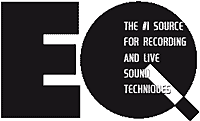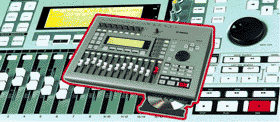AW16G Digital Audio Work Station (EQ Magazine, September 2002)
The competition for the ultimate all-in-one studio has produced a buyer's market where each new device seemingly outperforms the last…and the prices just keep dropping. With this kind of environment, any company hoping to get noticed had better come up with something pretty remarkable. Suffice it to say that Yamaha's AW16G got noticed big-time when it was introduced at summer NAMM. First, the basics: The compact AW16G records up to eight tracks simultaneously with 16-bit resolution (no data compression). Audio is recorded on an internal 20 GB IDE hard drive; eight virtual tracks are available for each track. 16 tracks (assigned to eight mono and four stereo faders) can play back at once.
However, the AW16G also has several features that optimize it as a “front end” for computer-based systems. The internal CD-RWdrive isn’t just for cutting finished audio CDs; you can export up to 16 tracks simultaneously as WAV files to a recordable or rewritable data CD, then bring these into your sequencer/harddisk recording program of choice for tweaking, adding plug-ins, doing additional overdubs, etc. All data is also compatible with Yamaha’s AW4416 and AW2816 workstations, which helps with collaborations and file-sharing. Another nod to computer-based editing is MIDI remote control templates for various sequencers and synthesizers, including Cakewalk Sonar (Sonar “test drive” software comes with the AW16G), E-Magic Logic, Steinberg Cubase and Nuendo, Digidesign Pro Tools, and the Yamaha Motif Music Production Synthesizer. Furthermore, the AW16G can serve as a 36-channel digital mixer with eight 24-bit mic/line inputs (two ins have XLR connectors with +48V phantom power). Channel 8 provides a high-impedance input for direct recording with guitar and bass — even those with high-impedance passive pickups. Other features include two effects busses (with two aux sends per channel), which also double as stereo outs, stereo monitor outs, headphone out, four channels of effects return, and optical I/O for direct digital connection to a synthesizer, MD player, DAT, computer audio interface, etc. All channels contain digital attenuators, four-band parametric EQ, dynamics, and channel split knobs. Many parameters for a selected channel, such as EQ, panning, dynamics, etc. are assigned to knobs for easy editing. Of course, there are some bells and whistles to further differentiate the AW16G. For example, an eight-channel, four-pad “quick loop sampler” contains 250 pre-set phrase samples and drum samples, and will record up to 16 samples with a total duration of 47 seconds. Also, a “sound clip” function allows capturing and looping vocal or guitar phrases, which simplifies practicing and learning lines. There are also two built-in stereo multieffects. Thirty-five presets (including five speaker emulation programs) are optimized for guitars, bass, and vocals, while 13 more effects are intended for mastering applications prior to creating a CD. Finally, there’s scene memory, a jog wheel function, marker insertion options for instant autolocation, autopunch, and undo/redo. Although the mixer doesn’t have the moving faders of its more expensive relatives, parameters can be automated through a MIDI sequencer synched to the AW16G. |
|||||||||||||||||||||||||
|
Copyright© 2002 United Entertainment Media, a CMP Media Information Company. All rights reserved. Used with permission. |
AW16G 16-Track Digital Audio Workstation




 By Craig Anderton
By Craig Anderton